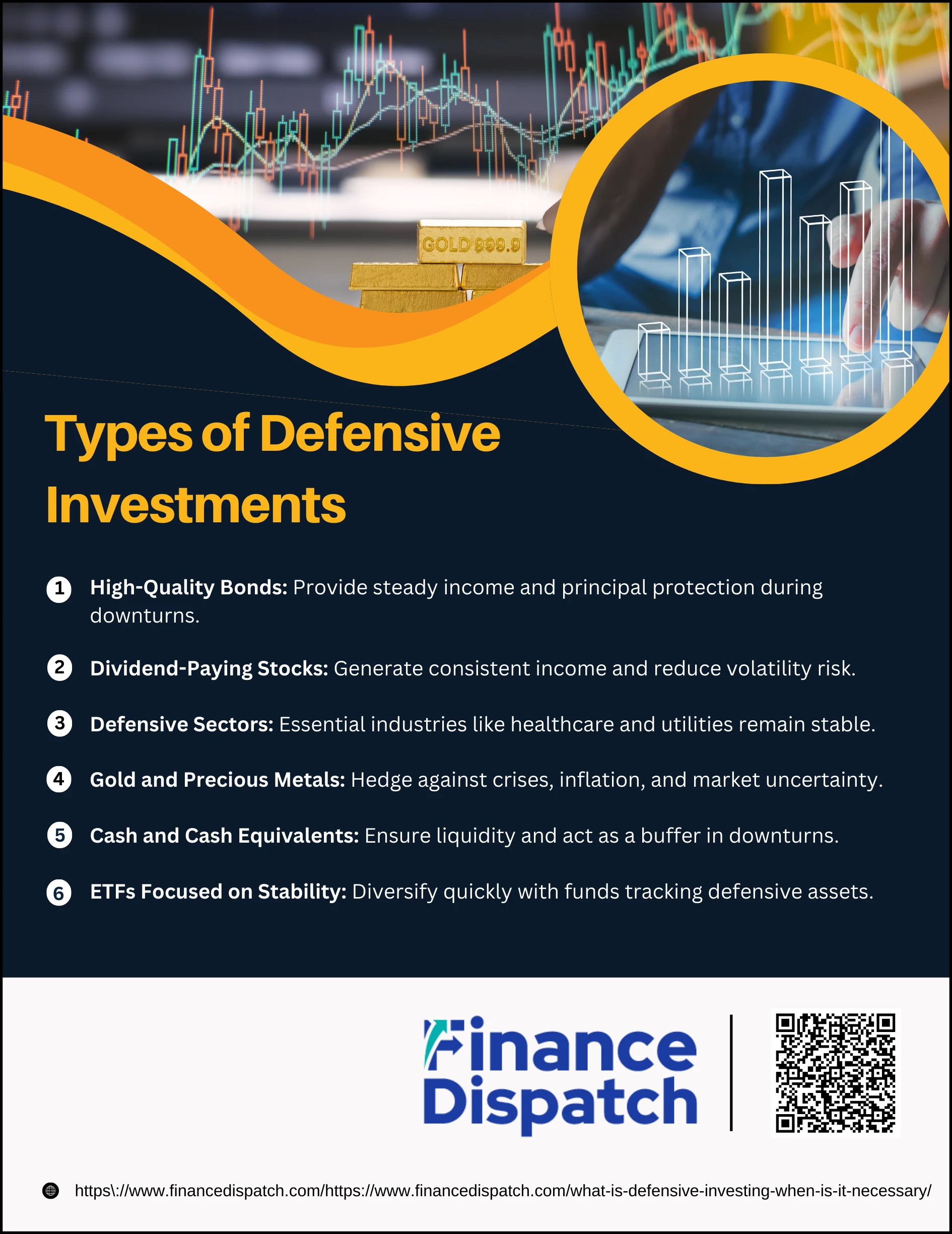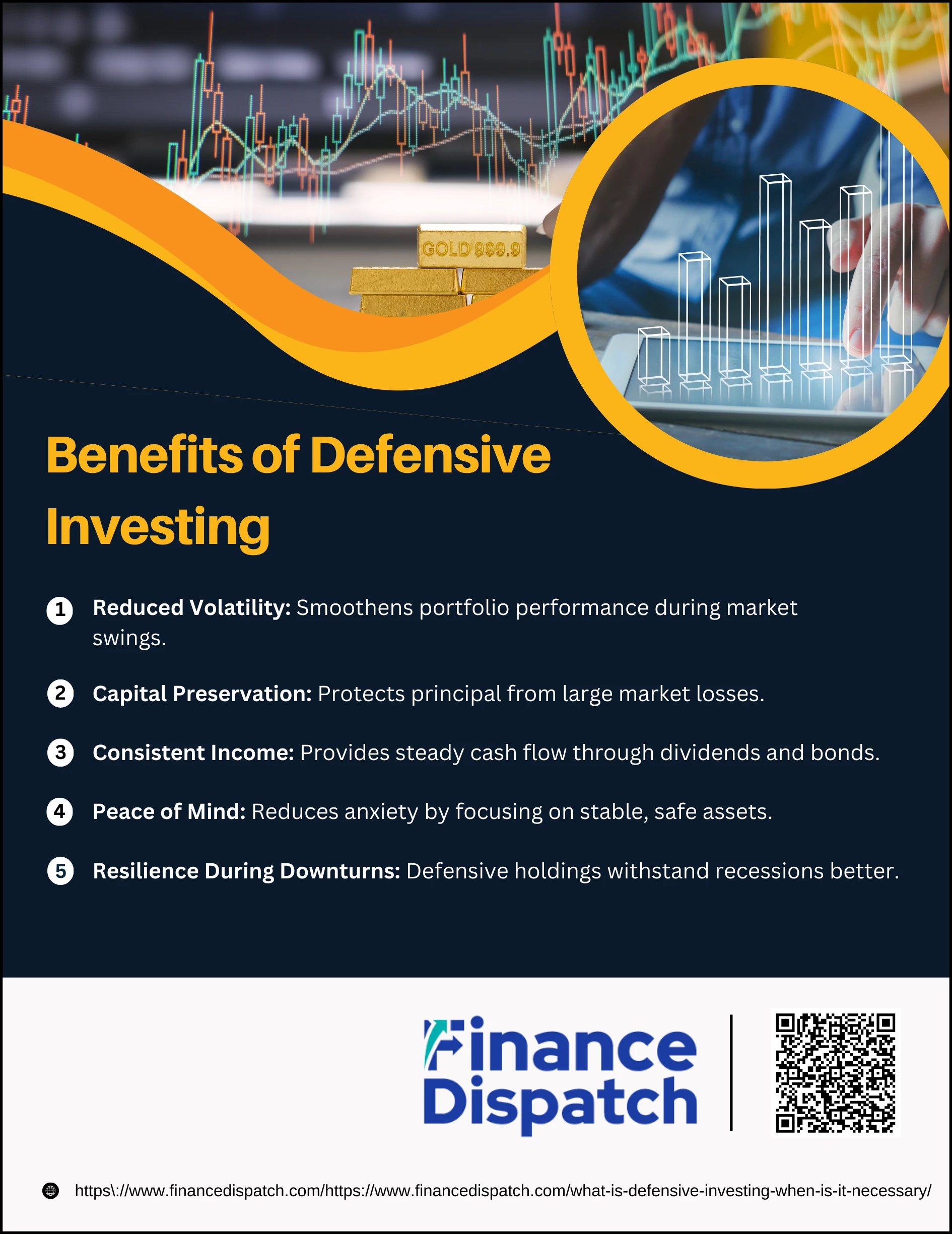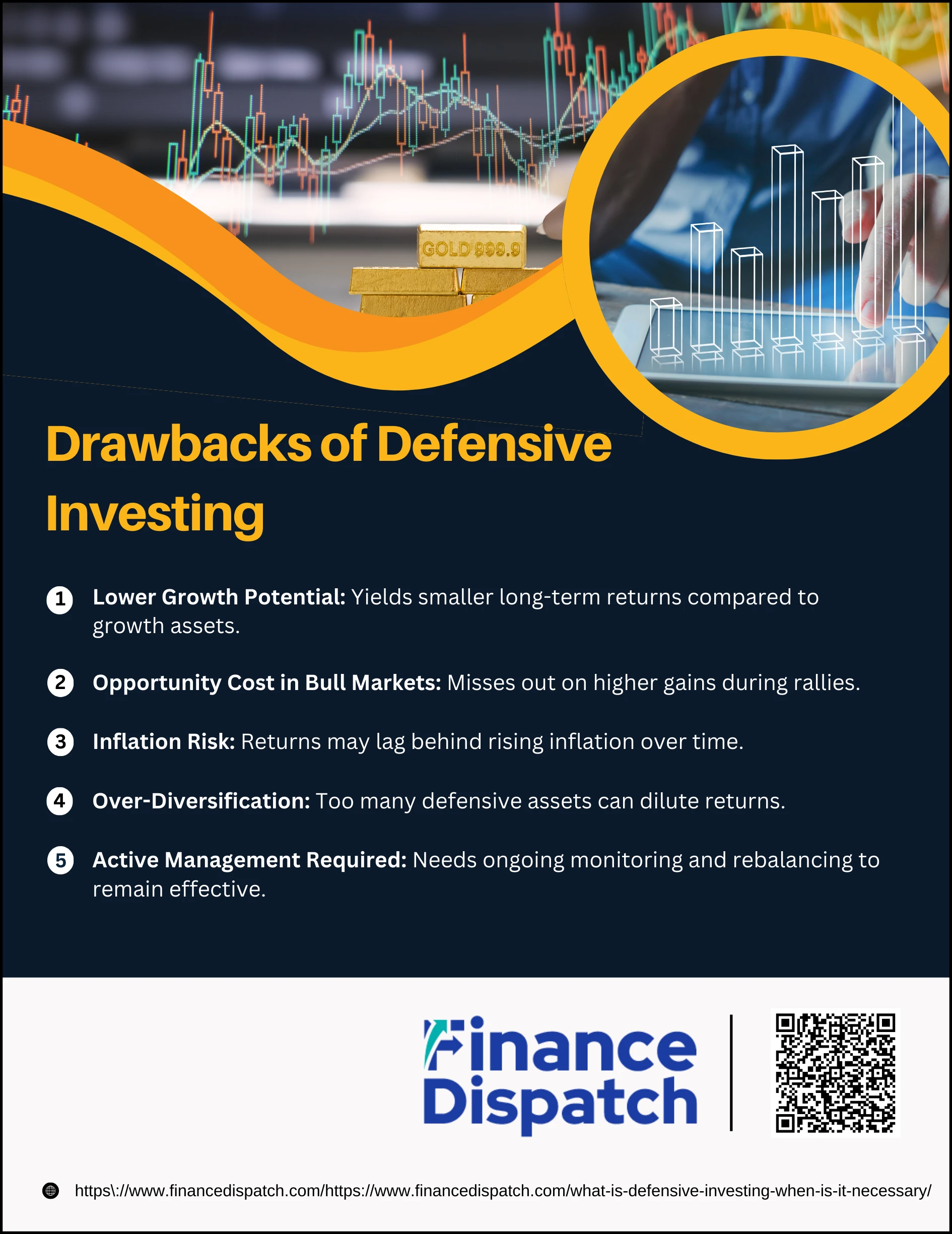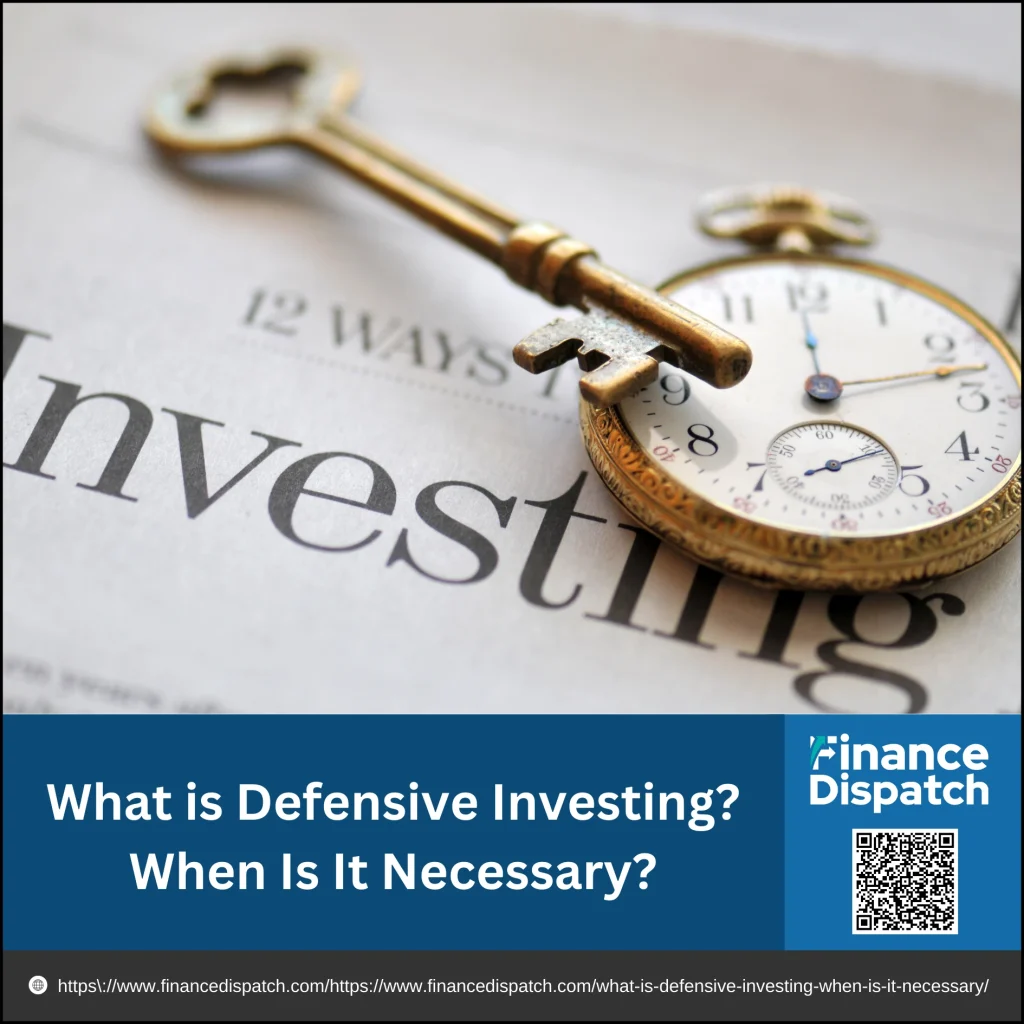In an unpredictable financial world where markets can swing sharply from highs to lows, many investors look for strategies that prioritize safety over rapid growth. This is where defensive investing comes in—a cautious approach that focuses on preserving capital, minimizing risks, and generating steady returns rather than chasing quick gains. Whether you’re approaching retirement, working with limited capital, or simply prefer peace of mind over market excitement, defensive investing offers a way to safeguard your portfolio during turbulent times while still keeping it on track for long-term stability.
What is Defensive Investing?
Defensive investing is an investment strategy designed to protect your money from major losses during uncertain or declining markets. Instead of chasing high returns through risky assets, this approach focuses on stability, capital preservation, and steady performance over time. It often includes safer investments such as government bonds, dividend-paying or blue-chip stocks, and assets in essential sectors like healthcare, utilities, and consumer staples. By emphasizing quality and reducing exposure to volatility, defensive investing helps create a portfolio that can withstand market downturns while still providing modest, reliable growth.
Core Components of Defensive Investing
Defensive investing is built around strategies and assets that help reduce risk while maintaining steady returns. Instead of focusing on aggressive growth, it emphasizes building a balanced portfolio that can endure economic downturns and market volatility.
Key components include:
1. High-Quality Bonds: Government or investment-grade corporate bonds that provide predictable income and stability.
2. Dividend-Paying or Blue-Chip Stocks: Shares of well-established companies known for consistent dividends and strong fundamentals.
3. Defensive Sectors: Investments in industries like healthcare, utilities, and consumer staples that remain in demand even during recessions.
4. Diversification: Spreading investments across asset classes, industries, and geographies to minimize risk exposure.
5. Cash and Equivalents: Holding some assets in cash, Treasury bills, or money market funds for liquidity and security.
 When is Defensive Investing Necessary?
When is Defensive Investing Necessary?
Defensive investing is not about avoiding growth altogether—it’s about knowing when stability and protection should take priority. Certain life stages, financial situations, and market conditions make this cautious approach especially valuable. Here are some of the key moments when defensive investing becomes necessary:
1. During Market Downturns
Economic recessions, bear markets, or unexpected crises can erode the value of riskier assets very quickly. A defensive portfolio—made up of stable investments like bonds, dividend-paying stocks, and essential sector holdings—helps cushion the blow. Instead of facing steep declines, investors can maintain stability and recover faster once markets stabilize.
2. Near Retirement
As retirement approaches, the focus shifts from building wealth to protecting it. At this stage, losing capital could jeopardize years of savings and future income security. Defensive investing prioritizes preservation by limiting exposure to volatile assets and emphasizing safer investments that generate consistent income.
3. For Risk-Averse Investors
Some investors simply prefer peace of mind over the stress of market fluctuations. If you find sharp ups and downs unsettling, or if you rely on your investments to fund daily expenses, defensive strategies are ideal. They allow you to stay invested without the constant worry of large losses.
4. When Capital is Limited
Investors with smaller amounts of capital have less room to absorb losses. Defensive investing helps protect what they already have while allowing for modest growth. This approach ensures that limited savings aren’t wiped out by risky market moves and instead grow steadily over time.
5. To Safeguard Gains
After a strong market rally or significant growth in a portfolio, shifting into a defensive position can lock in profits. By reallocating into safer assets, investors reduce the risk of giving back those hard-earned gains during the next downturn. It’s a strategic way of protecting past success while still keeping the portfolio active.
 Types of Defensive Investments
Types of Defensive Investments
Defensive investments are chosen for their resilience during market downturns and their ability to provide consistent returns. They don’t eliminate risk entirely, but they reduce exposure to sharp losses and create a stable foundation for long-term financial planning. Here are the main types explained in detail:
1. High-Quality Bonds
Bonds issued by governments or financially strong corporations are considered safe because they provide fixed interest payments and return the principal at maturity. U.S. Treasuries and investment-grade corporate bonds, for instance, are highly valued during downturns since they tend to hold steady when stocks decline. They offer predictable income and stability, making them a cornerstone of defensive portfolios.
2. Dividend-Paying Stocks
Companies with a long history of paying regular dividends, such as blue-chip firms, are seen as reliable investments. Even if stock prices fall temporarily, dividend payments continue to provide income, acting as a cushion against volatility. These stocks often belong to industries with steady demand, making them less sensitive to economic cycles.
3. Defensive Sectors
Certain industries are more resilient because their products and services are essential regardless of the economy. Healthcare, consumer staples (like food and household goods), and utilities (electricity, water, gas) are prime examples. These sectors maintain consistent earnings during recessions, making them attractive defensive investments.
4. Gold and Precious Metals
Gold has historically been a safe haven during financial crises, inflation, or geopolitical instability. Unlike stocks and bonds, it often moves independently of market cycles, providing diversification benefits. Precious metals like silver and platinum also serve as hedges against uncertainty, though gold remains the most widely used.
5. Cash and Cash Equivalents
Keeping part of a portfolio in cash or near-cash assets such as Treasury bills, money market funds, or certificates of deposit ensures liquidity. These holdings act as a buffer during downturns, allowing investors to cover expenses or take advantage of buying opportunities when markets recover. The downside is that returns are low and may not keep pace with inflation.
6. Exchange-Traded Funds (ETFs) Focused on Stability
Defensive ETFs provide broad exposure to stable assets without the need to pick individual investments. For example, ETFs that track dividend aristocrats, utilities, or bond indices allow investors to diversify quickly and reduce volatility. They combine the safety of defensive investing with the flexibility and accessibility of modern markets.
Key Principles of Defensive Investing
Defensive investing is not just about choosing safe assets—it’s about following disciplined principles that protect your capital while ensuring steady, long-term growth. These principles guide how a portfolio is built, managed, and adjusted to weather different market conditions.
Core principles include:
1. Diversification: Spread investments across asset classes, sectors, and regions to reduce risk from any single source.
2. Focus on Quality: Choose assets like blue-chip stocks, government bonds, and companies with strong fundamentals and consistent earnings.
3. Capital Preservation First: Prioritize protecting your initial investment over chasing high-risk, high-reward opportunities.
4. Income Generation: Include dividend-paying stocks and bonds that provide steady cash flow, even when markets are volatile.
5. Long-Term Perspective: Avoid short-term speculation; defensive investing works best with patience and discipline.
6. Risk Management: Use tools such as stop-loss orders, portfolio rebalancing, and regular reviews to limit exposure to downturns.
 Benefits of Defensive Investing
Benefits of Defensive Investing
Defensive investing isn’t about eliminating risk completely but about building a safety net that keeps your portfolio stable through both good and bad times. By focusing on stability and preservation, this approach offers several meaningful advantages that appeal to risk-averse investors and those nearing important financial milestones.
Key benefits include:
1. Reduced Volatility
Defensive investments—such as government bonds, utility stocks, and consumer staples—don’t react as sharply to economic changes as growth stocks do. This means your portfolio experiences smaller ups and downs, providing smoother overall performance. Reduced volatility makes it easier to stay invested without panic-selling during turbulent periods.
2. Capital Preservation
One of the main goals of defensive investing is to safeguard your principal, or the money you initially put in. By emphasizing safer assets, you lower the chance of major losses, which is especially crucial for retirees or anyone who cannot afford to rebuild their savings after a market crash.
3. Consistent Income
Many defensive assets, such as dividend-paying stocks, high-quality bonds, or even certain real estate funds, provide regular income. This steady cash flow acts as a cushion, allowing investors to cover expenses or reinvest, even if the market is underperforming.
4. Peace of Mind
Knowing your investments are focused on stability helps reduce anxiety during uncertain times. Defensive investors don’t need to monitor the markets constantly or worry about sudden downturns, which makes financial planning less stressful and easier to manage.
5. Resilience During Downturns
Defensive portfolios typically hold up better when the economy slows or enters a recession. Sectors like healthcare, utilities, and consumer goods remain in demand, so their stocks often decline less—or even grow—when other areas of the market are falling. This resilience helps investors avoid the deepest losses and positions them for quicker recovery when markets rebound.
 Drawbacks of Defensive Investing
Drawbacks of Defensive Investing
Defensive investing provides stability and protection, but no strategy is perfect. The very features that make it safe can also limit its long-term effectiveness. By recognizing the potential downsides, investors can make better decisions about when and how to apply this approach.
Key drawbacks include:
1. Lower Growth Potential
Defensive assets like government bonds or blue-chip dividend stocks usually deliver smaller returns than high-growth investments. While they preserve capital, they don’t provide the same wealth-building opportunities as riskier assets such as emerging market stocks or technology companies. Over decades, this slower growth can significantly reduce the size of your portfolio compared to a more aggressive approach.
2. Opportunity Cost in Bull Markets
During strong economic expansions or stock market rallies, defensive portfolios often underperform. For example, while growth stocks may soar by 20–30% in a bull market, defensive assets may only yield 5–10%. By sticking to safe options, investors miss out on larger gains, creating an opportunity cost that could affect long-term goals.
3. Inflation Risk
Assets like bonds, Treasury bills, or money market funds may provide stability, but their returns often struggle to keep pace with inflation. Over time, this erodes purchasing power—meaning the same amount of money buys less in the future. For retirees or income-dependent investors, this can be a serious drawback if inflation rises faster than portfolio returns.
4. Over-Diversification
While diversification reduces risk, spreading investments across too many defensive assets can dilute returns. For example, owning excessive amounts of similar low-yield bonds or cash equivalents may add little additional protection but significantly reduce growth potential. Over-diversification can also make managing the portfolio unnecessarily complex without meaningful benefits.
5. Active Management Required
Defensive investing is not a “set it and forget it” strategy. Portfolios still require regular reviews, rebalancing, and adjustments to remain effective. Market conditions change, and what is considered defensive today may not hold the same protective value tomorrow. For example, bonds that once provided safety may lose value when interest rates rise. Without ongoing oversight, the strategy may fail to deliver the intended protection.
Implementing Defensive Strategies
Defensive investing is most effective when it’s built on careful planning and consistent execution. Rather than reacting to every market movement, investors can use practical steps to design a portfolio that protects capital, reduces risk, and still delivers steady long-term returns.
Ways to implement defensive strategies include:
1. Set Clear Goals and Risk Tolerance: Define what you want to achieve and how much risk you can comfortably handle before choosing investments.
2. Choose Stable Assets: Focus on high-quality bonds, blue-chip or dividend-paying stocks, and sectors like healthcare, utilities, and consumer staples.
3. Diversify Across Classes and Sectors: Spread investments across stocks, bonds, cash, and possibly real estate or commodities to reduce overall risk.
4. Rebalance Regularly: Adjust your portfolio periodically to maintain the intended mix of assets as markets shift.
5. Maintain Liquidity: Keep some holdings in cash or cash equivalents to cover expenses or take advantage of opportunities during downturns.
6. Use Risk Management Tools: Apply strategies like stop-loss orders or conservative asset allocations to limit potential losses.
Conclusion
Defensive investing is about balance—protecting your wealth while still allowing it to grow steadily over time. By focusing on stable assets, diversification, and risk management, this strategy helps investors weather downturns and maintain financial security when markets are uncertain. While it may not deliver the fastest returns, it offers peace of mind and resilience, making it especially valuable for those nearing retirement, risk-averse individuals, or anyone looking to safeguard gains. Ultimately, defensive investing reminds us that successful investing isn’t always about chasing the highest profits—it’s about building a portfolio that can stand strong through both calm and turbulent times.



